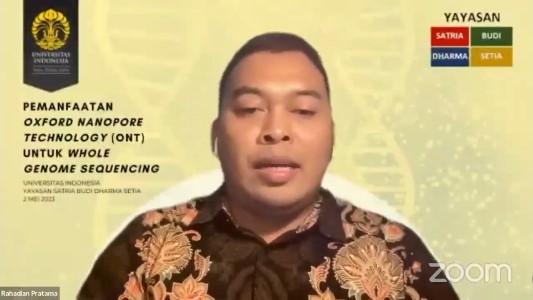Dr Rahadian Pratama Introduces Some Indonesian Woody Plant Research with Oxford Nanopore Technology

Dr Rahadian Pratama, IPB University lecturer from the Department of Biochemistry, Faculty of Mathematics and Natural Sciences (FMIPA) introduced genome sequencing technology with Oxford Nanopore Technologies (ONT). This technology is used in several forest timber harvesting plant studies at IPB University.
"This technology is very suitable to explore Indonesian native woods that have great potential. The background is that Indonesian forest wood plants are rarely interested and explored for their potential. This ONT technology has been used by IPB University in several studies from 2020 to the present," he said.
According to him, this renewable technology is the third generation of DNA sequencing. He said that this technology has been used for research on ebony forests from Makassar, one of the plants that are vulnerable to illegal logging.
"IPB University researchers created an analysis method to identify the wood that has been cut down. Research related to phylogenetic analysis has even been published in various national and international publications," he explained in the Webinar on the Utilization of Oxford Nanopore Technology for Whole Genome Sequencing with the Directorate of Research and Development of the University of Indonesia (2/5).
Dr Rahadian even mentioned that IPB University master students have also used this technology to research several rare trees, namely Damar Mata Kucing (Shorea javanica) and Pelahlar (Dipterocarpus littoralis). These trees have been used by the community for building materials for houses and boats, paints, and perfumes.
The analysis was carried out in the form of biosynthetic gene clusters, and genetic exploration to find potential plant functions obtained from various metabolite data.
"This third-generation sequencing technology is based on real-time. The tool can read DNA sequences quickly with a portable and small form, long readings, and high-throughput. The disadvantage is that the reading accuracy is very low, but the development to date is considered better," he explained.
Meanwhile, he continued, at IPB University the ONT used is MinION. The MinION type is suitable for starting research or small and limited research. For example, for research on plant, animal, and bacterial genomes.
"As for laboratory routines, it is more suitable to use GridION or PromethION for large research. For example, for DNA research that requires a large enough output," he concluded. (MW/Rz) (IAAS/TNY)



